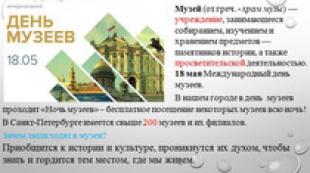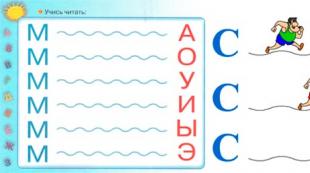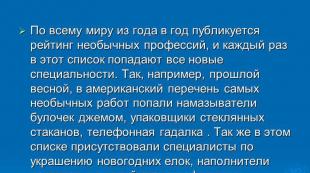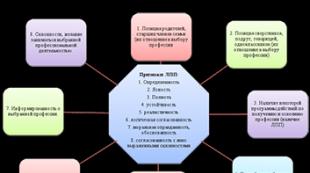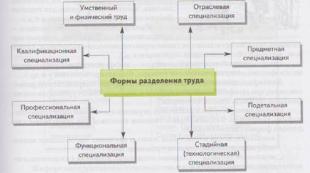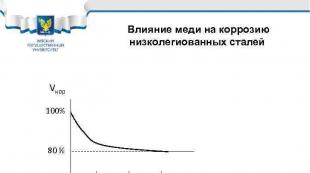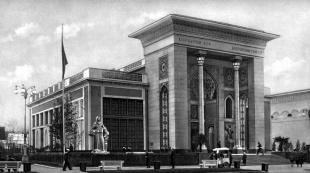Presentation "Features of teaching preschool children." Methods of teaching preschoolers Presentations for home education lessons for preschoolers
To use presentation previews, create a Google account and log in to it: https://accounts.google.com
Slide captions:
Teaching children storytelling - as a means of developing coherent speech Prepared by teacher-speech therapist: Zhmurova E.A.
Relevance The problem of teaching children storytelling is quite relevant. To successfully master the school curriculum, a kindergarten graduate must develop the ability to coherently express his thoughts, build a dialogue and compose a short story on a specific topic. Of particular interest is teaching children to tell a story based on a picture, a series of plot pictures, since their preparation and implementation has always been and remains one of the most difficult for both children and the teacher. The basis of storytelling based on the picture is the children’s perception of the life around them. The picture not only expands and deepens children's ideas about social and natural phenomena, but also affects children's emotions, arouses interest in storytelling, and encourages even the silent and shy to speak. Teaching a child to tell means forming his coherent speech
Objectives: Improving the lexical, grammatical and phonetic aspects of children’s speech, enriching the vocabulary; Developing the ability to tell stories logically, meaningfully, interestingly and expressively; Improving monologue speech through various forms of work; Formation of children's intellectual and creative abilities (the ability to compose creative stories).
Stages of training Determining the composition of the picture; Establishing relationships between objects; Description based on the possible perception of objects in the picture by different senses; Making up riddles and metaphors based on the picture; Transformation of objects in time; Description of the location of objects in the picture; Compiling stories from the perspective of different objects; Semantic characteristics of the picture; Compiling fantasy stories; Compilation of fairy tales of a moral and ethical nature.
Types of storytelling 1. Storytelling using toys and objects. 2. Storytelling based on the picture. 3. Storytelling from personal experience 4. Creative storytelling (storytelling based on suggested plots)
SERIES OF PICTURES USED IN KINDERGARTEN: Subject paintings - they depict one or more objects without any plot interaction between them (furniture, clothing, dishes, animals; “Horse with a foal”, “Cow with a calf” from the “Domestic” series animals” - author S. A. Veretennikova, artist A. Komarov).
Reproductions of paintings by masters of art: - landscape paintings: A Savrasov “The Rooks Have Arrived”; I. Levitan “Golden Autumn”, “Spring. Big Water", "March"; A. Kuindzhi “Birch Grove”; I. Shishkin “Morning in a pine forest”, “Forest cutting”; V. Vasnetsov “Alyonushka”; V. Polenov “Golden Autumn” and others; Still life: K. Petrov-Vodkin “Birch cherry in a glass”, “Glass and apple branch”; I. Mashkov “Rowan”, “Still Life with Watermelon”; P. Konchalovsky “Poppies”, “Lilacs at the Window”.
REQUIREMENTS FOR THE SELECTION OF PICTURES The content of the picture should be interesting, understandable, and foster a positive attitude towards the environment; the picture must be highly artistic: images of characters, animals and other objects must be realistic; the picture should be accessible not only in terms of content, but also in terms of image. There should be no pictures with an excessive accumulation of details, otherwise children will be distracted from the main thing.
General requirements for organizing work with a picture: 1. It is recommended to carry out work on teaching children to tell stories based on a picture, starting from the 2nd junior group of kindergarten. 2. When selecting a plot, it is necessary to take into account the number of objects drawn: the younger the children, the fewer objects should be depicted in the picture. 3. After the first game, the picture is left in the group for the entire duration of classes with it (two to three weeks) and is constantly in the children’s field of view. 4. Games can be played with a subgroup or individually. However, it is not necessary that all children go through every game with a given picture. 5. Each stage of work (series of games) should be considered as intermediate. The result of the stage: the child’s story using a specific mental technique. 6. The final story can be considered a preschooler’s detailed story, constructed by him independently with the help of learned techniques.
Types of storytelling based on a painting 1. Description of subject paintings is a coherent, sequential description of the objects or animals depicted in the painting, their qualities, properties, actions 2. Description of a subject painting is a description of the situation depicted in the painting, which does not go beyond the content of the painting. 3. A story based on a sequential plot series of pictures: the child talks about the content of each plot picture from the series, linking them into one story.
4. Narrative story based on a plot picture: the child comes up with a beginning and an end to the episode depicted in the picture. He needs not only to comprehend the content of the picture and convey it, but also, with the help of his imagination, to create preceding and subsequent events. 5. Description of a landscape painting and still life. An example of a description of I. Levitan’s painting “Spring. Big water” by a 6.5 year old child: “The snow melted and everything around was flooded. The trees are in the water, and there are houses on the hill. They weren't flooded. Fishermen live in the houses, they catch fish.”
Teaching children to look at pictures
Stages of teaching storytelling from a picture Junior preschool age The preparatory stage is carried out. Its purpose is to enrich the vocabulary, activate children's speech, teach them to look at pictures and answer questions about their content. Didactic games are played with object pictures: kids must match the indicated picture, name the object, say what it is, what they do with it.
When working with children, we use subject and plot paintings that are close to the children’s experience and evoke an emotional response: “Cat with Kittens”, “Dog with Puppies”, “Cow with Calf”, “Our Tanya”. The main type of lesson on painting is conversation. Children learn to tell stories with the help of the teacher's questions. The teacher sets the pattern, and the children add: “The cat Murka is lying on... (rug), she has small... (kittens).” Author's stories on the topic, riddles, short poems, nursery rhymes are used.
Descriptive story Goal: development of coherent speech based on the reflection of what was seen. Types of descriptive story: fixation of the objects depicted in the picture and their semantic relationships; description of the picture as a disclosure of a given theme; a detailed description of a specific object; verbal and expressive description of what is depicted using analogies (poetic images, metaphors, comparisons, etc.).
Middle preschool age Children are taught to examine and describe subject and plot pictures, first according to the questions of the teacher, and then according to his example. The technique of comparing two characters is used. Conversations are held based on the plot pictures, ending with a generalization made by the teacher or the children. Structure of the lesson: 1. children silently examine the picture, 2. a conversation is held to clarify the content and details, 3. a sample is given (short, lively, emotional), 4. children reproduce the sample, 5. tell it independently, bringing their creativity into the story.
Children are led to storytelling through a series of story pictures (no more than three). Each picture from the series is examined and described, then the children’s statements are combined into one story by the teacher or children.
Senior preschool age: Children independently or with a little help from the teacher describe subject and plot pictures, compose plot stories based on a series of pictures, come up with the beginning and end of the plot of the picture. The learning tasks become more complicated: children must not only understand the content of the picture, but also coherently and consistently describe all the characters, their relationships, and the setting, using a variety of linguistic means and more complex grammatical structures. The main requirement is greater independence in telling stories based on pictures.
In the older group, the following paintings are recommended: “The Ball Flew Away”, “New Girl”, “At the Pier”, “Horse with a Foal”, “Hedgehogs”, “Squirrels”, etc. Children are taught the following types of statements: - description and comparison of subject paintings; - description of plot paintings; - narration based on a series of plot paintings.
Lesson structure: Examination of paintings and clarification of the main points of the plot are used. Methodological techniques: questions, speech sample, collective storytelling, discussion of the narrative sequence, creative tasks, plan in the form of questions and instructions. Training in constructing a story based on a series of plot paintings continues.
Options for presenting pictures to compose a collective story based on a plot series 1. A set of pictures with a deliberately broken sequence is displayed on the board. Children find a mistake, correct it, come up with a story title and content based on all the pictures; 2. The entire series of pictures is on the board, the first picture is open, the others are closed. After describing the first, the next one is opened in order; Each picture is described. At the end, the children give the name of the series and select the most successful one; 3. Children place incorrectly located pictures in the correct sequence, then compose a story based on the whole series. 4. They agree among themselves who will tell the story in what order.
Preparatory group for school Children independently compose descriptions and narratives based on the pictures, correctly conveying the content, observing the appropriate structure, and using figurative speech. All types of pictures and all types of children's stories are used. Particular attention is paid to independence and creativity. A work of art is often used as a speech sample: short stories by L. N. Tolstoy, K. D. Ushinsky, E. Charushin, V. Bianki.
Lesson structure The story is based on multi-episode films “Winter Fun”, “Summer in the Park”, “City Street”. The paintings are examined in parts, creative tasks are used, and children are encouraged to ask questions themselves; the vocabulary is activated and enriched with figurative expressions (epithets, comparisons, metaphors). The teacher can start a story about one of the episodes, the children continue. Instructions are used on who to start with, what to tell first, and in what sequence to develop the plot. After such explanations and instructions, children take part in collective storytelling.
Teaching children to tell stories from a picture
A special type of coherent statement is descriptive stories based on a landscape painting. This type of story is especially difficult for children. If, when retelling and composing a story based on a plot picture, the main elements of the visual model are characters - living objects, then in landscape paintings they are absent or carry a secondary semantic load. In this case, natural objects act as elements of the story model. Since they, as a rule, are static in nature, special attention is paid to describing the qualities of these objects. Work on such paintings is built in several stages: identifying significant objects in the painting; examination of them and a detailed description of the appearance and properties of each object; determining the relationship between individual objects in the picture; combining mini-stories into a single plot.
As a preparatory exercise in developing the skill of composing a story based on a landscape painting, we can recommend the work “Bring the Picture to Life.” This work is like a transitional stage from composing a story based on a plot painting to telling a story using a landscape painting.
Conclusion In teaching storytelling, enriching the motives of children’s speech activity is of particular importance. Motivational attitudes make the learning process interesting, attractive, increase the activity of children and the quality of their stories. In the junior and middle groups, these are mainly playful motives (“Let’s tell about a bunny who wants to play with the guys”; “Dunno asks to learn how to tell fairy tales about”). In older groups, these are social motives (“Come up with fairy tales for kids”; “Let’s write down the most interesting fairy tales and compile a book”). Thus, the methods of teaching preschoolers storytelling are varied. The method of using them changes at different stages of learning and depends on the type of storytelling, on the tasks at hand, on the level of children’s skills, on their activity and independence.
Sources used: “Program of education and training in kindergarten” by M.A. Vasiliev; “Program for the development of speech of preschoolers” by O.S. Ushakov; “Technologies for the development of coherent speech in preschool children” T.A. Sidorchuk, N.N. Khomenko; “Teaching creative storytelling from a picture” T.A. Sidorchuk, A.B. Kuznetsova.
Slide 2
Preschool didactics
Ya.A. Komensky "Mother's School". The purpose of preschool education: mastering a variety of knowledge about the world around us, moral development and preparation for school. Preference is for the organization of sensory cognition. F. Froebel developed a system of teaching in kindergartens, down to the teacher’s verbal explanations, children’s responses, poetic or song accompaniment of the actions performed.
Slide 3
V.F. Odoevsky “The ABC for use in orphanages”, “Science before science. The book of grandfather Irenaeus."
The main task is to teach children to learn, to develop their mental abilities, without striving for an abundance of knowledge. Exercises to develop the skills to observe, compare, analyze, name objects and determine their purpose.
Slide 4
K.D. Ushinsky “Native Word”, “Children’s World”. Development of the child’s mental strength and speech, formation of the ability to manage his mental processes and behavior. N.K. Krupskaya. Doshk. education should guarantee the child the right to education (knowledge of the world around him, broadening his horizons, accumulating knowledge).
Slide 5
In the 50s A.P. Usova. Doshk. training – unity of educational, training and educational work. By the 60s. methods of musical education (N.A. Metlov, N.A. Vetlugina), teaching the native language (O.I. Solovyova), development of basic movements (A.I. Bykova), visual arts (N.P. Sakulina), formation elementary mathematical concepts (A.M. Leushina).
Slide 6
At the present stage, psychological and pedagogical research is emerging: age-related opportunities for acquiring knowledge (A.V. Zaporozhets, D.B. Elkonin, V.V. Davydov); ways to implement the developmental function of preschools. training (L.A. Wenger, N.N. Poddyakov); use of information technologies (S.L. Novoselova, L.A. Paramonova, S.A. Kozlova, A.N. Davidchuk, etc.); communication in the process of solving an educational problem (E.V. Subbotsky, N.Ya. Mikhailenko, N.A. Korotkova).
Slide 7
Learning process
Specially organized interrelated activities of those who teach (teaching) and those who are taught (teaching).
Slide 8
Principles of training
Objective patterns, starting points that guide the teacher when selecting content, determining forms of organization, methods and means of teaching.
The principle of educational training. Arbitrariness of behavior and mental processes is developed; mastering communication skills. The principle of developmental education requires that the educational process be oriented toward the child’s potential capabilities (L.S. Vygotsky, ZPD). The principle of science. The child’s assimilation of real knowledge that correctly reflects reality.
Slide 10
The principle of accessibility. Rules according to J.A. Komensky: move from studying what is close (history of the native land) to what is far (universal history); move from easy to difficult, from known to unknown. The principle of learning at a high level of difficulty (L.V. Zankov). Learning requires serious effort.
Slide 11
The principle of visibility. Overestimation of clarity can delay the development of verbal and logical thinking. The principle of systematicity and consistency. Logical structure of the content and learning process. The principle of awareness of the learning process (I.Ya. Lerner). Development of a reflective position in a child: how I found out that I don’t know, how I thought before, why I was wrong, what I want to know, etc.
Slide 12
Learning Models
The educational and disciplinary model is an authoritarian style. The training motto is “If you can’t, we’ll teach you, if you don’t want to, we’ll force you.” Personality-oriented interaction between teacher and child. The purpose of education is the development of the child’s intellectual, spiritual, physical abilities, interests, and motives.
Slide 13
Visual methods
Observation is the ability to peer into the phenomena of the surrounding world, highlight the essential, the main in them, notice the main thing, reflect on what is seen, express thoughts in words. K.D. Ushinsky: “If teaching claims to develop the mind in children, it should exercise their ability to observe.”
Slide 14
Surveillance Requirements
The object of observation should be interesting for children; Observation under conditions that allow one to identify its characteristic features; The teacher outlines the purpose of observation, determines the range of new knowledge; The acquired knowledge should be developed in children’s activities (retelling, drawing, modeling, artistic work, play); Accompany the observation with an exact word: name objects, their signs, actions.
Slide 15
Demonstration (viewing)
Display of paintings, reproductions, filmstrips, slides, videos, etc. gives the child a visual image of familiar and unfamiliar objects. Pictures and diagrams form static visual images. Technical teaching aids are used to create dynamic visual images.
Slide 16
Practical methods
Exercise Experiments and experimentation. Modeling.
Slide 17
Exercise
Repeated repetition by a child of mental or practical actions of a given content. Identification of hidden signs using elementary experiments (transforming water into steam, snow into water, experiments with sand and clay, with wax). Develops observation skills, the ability to compare, contrast, make assumptions, and draw conclusions.
Slide 18
Modeling
Visual and practical teaching method. Model is a generalized image of the essential properties of the modeled object (room plan, geographical map, globe, etc.). Modeling is based on the principle of substitution: a real object is replaced by another object, its image, a conventional sign (D.B. Elkonin, L.A. Wenger, N.A. Vetlugina, N.N. Poddyakov). A pebble is a candy, sand is a porridge for a doll, a child is a dad, a driver, etc.
Slide 19
The purpose of models is to facilitate the child’s cognition, to open access to the hidden properties, qualities of things, and their connections. Models of teaching sound analysis of words (L.E. Zhurova), construction (L.A. Paramonova), for the formation of natural history knowledge (N.I. Vetrova, E.F. Terentyeva), ideas about the work of adults (V.I. Loginova , N.M. Krylova) and others.
Slide 20
Terms of Use for Simulation
Preschoolers have developed the ability to analyze, compare, generalize, and abstract from unimportant features when learning a subject.
Slide 21
Gaming methods and techniques
They cause increased interest, positive emotions, help to concentrate attention on the educational task, which becomes not imposed from the outside, but a desired, personal goal.
Didactic games, an imaginary situation in expanded form.
Slide 22
Didactic game
1 function – improvement and consolidation of knowledge. The child transforms, transforms them, learns to operate with them depending on the game situation. Function 2 – mastering new knowledge and skills of different content. (In the game “North, South, East, West,” preschoolers learn to navigate by compass and use route maps.)
Slide 23
An imaginary situation in expanded form
Knowledge about plants – game “Flower Shop”; Knowledge about your hometown - a travel game; About arts and crafts - the game “Exhibition”, “Souvenir Shop”, “Journey to the Past”. Making and guessing riddles, introducing elements of competition (in older groups), creating a game situation (“Let’s show the bear our toys”; “Let’s teach Parsley to wash his hands”; “Let’s help the bunny arrange the pictures”).
Slide 24
They allow you to convey information, set an educational task, and indicate ways to solve it: Teacher's story Conversation Introductory and general conversations Reading fiction
Slide 25
Teacher's story
Knowledge of various contents is conveyed in figurative form: about current events, about the seasons, about writers, composers, artists, about their hometown, etc. The teacher’s stories from personal experience “My first teacher”, “How I learned to read”, “Games of my childhood”, “My favorite toy”, “My friends”, etc. are interesting. Demonstration of visual material (objects, their images).
Slide 26
Conversation
It is used in cases where children have some experience and knowledge about the objects and phenomena to which it is dedicated. Develops the ability to listen to each other, not interrupt, complement, not repeat what has already been said, and evaluate statements tactfully and kindly. Teaches you to think logically, express yourself definitely, draw conclusions, generalizations, educates children’s feelings, and forms an attitude towards the events in question.
Slide 27
Types of conversations by content
Ethical – education of moral feelings, formation of moral ideas, judgments, assessments. Topics: “About politeness”, “How to behave at home and on the street”, “About friend and friendship”, “My beloved grandmother”, etc. Accompanying the conversation with reading a work of art, showing illustrative material, showing a film.
Slide 28
Cognitive conversation is determined by the curriculum and is related to the content of children’s lives, current life events, the surrounding nature and the work of adults.
Slide 29
Conversations for didactic purposes
The introductory course prepares children for the upcoming activity and observation. The teacher identifies children’s experiences, updates knowledge that is the basis for the perception of new objects and phenomena, and arouses interest in activities. Summarizing is carried out with the aim of summarizing, clarifying, and systematizing knowledge. Techniques: storytelling by the teacher and children, reading poems, listening to music, commenting on visual material.
Slide 30
Reading fiction
Fiction is a source of knowledge about the world around us, the most important means of educating a child’s feelings, developing thinking, imagination, and memory. Requirements: compliance with the age and level of development of children, preparation of the perception of the work through a short conversation, setting an educational task, after reading a conversation that helps to understand the content of the work. Verbal techniques: questions to children, instructions, clarification, explanation, pedagogical assessment.
Slide 31
Types of questions (A.I. Sorokina)
Requiring a simple statement of facts known to the child (who?, what?, which?, where?, when?). Encouraging children to think, to formulate conclusions (why?, why?, why?, for what purpose?).
Slide 32
Forms of training organization
Individual Group (with a subgroup) Frontal (with the whole group)
Slide 33
Customized form
Correspondence of objectives, content, methods and means of teaching to the child’s developmental level. Uneconomical. Great nervous costs, emotional discomfort for the child. Psychologically, a child is always closer to another child. He “takes information” from an adult, learns methods of action, and looks at a peer as if in a mirror: what am I like?
Slide 34
Necessary for frequently ill children who have behavioral problems (restless, increased excitability, impulsive behavior, etc.), with clearly expressed abilities for one or another activity (drawing, singing, mathematics, etc.).
Slide 35
Group form of training
The basis for the subgroup is the personal sympathy of the children, the commonality of their interests, but not the coincidence in levels of development. Subgroups should sit autonomously. The topic of the lesson is common to everyone.
Slide 36
Frontal exercises
Slide 38
Excursion structure
Preparatory stage. The topic, content, and timing are outlined. Formulates questions, selects fragments from poems, proverbs and sayings. Techniques and means: communicating new information, updating children’s experience, using works of art to influence the child’s emotional sphere.
Slide 39
During the excursion, the leading method is observation. Questions: focusing attention, requiring statements of facts (what is it called, what parts, what qualities does it have, etc.); activating thinking (to establish connections, relationships); stimulating the activity of the imagination, encouraging creative thinking, conclusions, judgments.
Slide 40
Post-excursion work is aimed at expanding, clarifying, and systematizing knowledge. Techniques: design of materials brought from the excursion (cones, acorns, stones, etc.), appeal to art. works, work in the book corner (designing the albums “Our City”, “Our Park”, “Who Lives in the Forest”, etc.), in the nature corner (making models, herbariums, etc.), organizing games, summarizing conversations.
View all slides
Presentation for classes in the senior, preparatory group of kindergarten. Acquaintance with the most famous and age-appropriate museums of St. Petersburg. Purpose of the lesson: introducing preschoolers to the history and culture of their hometown. At the end of the presentation there are questions to check the degree of mastery of the material.

Summary of a drawing lesson with children of the senior group “Still Life”
Job objectives:
1. Develop children’s abilities for visual arts (sense of color, composition)
2. Encourage children to independently convey images, using the means of expression available to them (color, shape)
3. Continue to introduce children to painting genres.
4. Continue to develop fantasy and imagination.
Materials: multimedia presentation, wax crayons, sheets of paper, fruit or fruit replicas.
Progress of the lesson:
The teacher and the children examine the brought fruits.
What shape, what color, how it feels.
The teacher invites the children to listen to one story that happened with these fruits and includes a presentation.
“Once upon a time there lived four friends - Apple, Apricot and two sisters Plum. But one day there was a quarrel between them because each decided that he was the most beautiful and the most delicious.
“I am the most beautiful,” said Apple and walked away from his friends. “No, I’m the most beautiful,” said the apricot and also stepped aside. “No, no, we are the most delicious, the most elegant and the sweetest,” the Plums shouted, but no one heard them, because the friends ran away in different directions. But then Orange came to them and said that each of them was beautiful and tasty in its own way. Orange reconciled friends.”
The teacher invites the children to draw a fragment of this story (two fruits together, one to the side, three together, etc.)
After the children finish drawing, the teacher asks the children the name of the picture that depicts flowers, fruits, vegetables, and dishes.
After the children’s answers, he sums it up: “Yes, still life is correct. Today we all painted a still life. Look how different they turned out, despite the fact that we depicted the same fruits. It all depends on how we arrange objects on a sheet of paper. It's called composition"
The teacher invites the children to come up with their own story with fruits at home and draw a fragment from it.


Target audience: for preschoolers
Presentation for an extracurricular activity for a preschool class. Objectives of the event: to develop children's knowledge of ordinal counting within 10 (forward and backward counting). To consolidate and generalize children's knowledge about the properties of geometric shapes. Develop the ability to compare numbers. Improve children's ability to navigate in space. Develop attention, thinking, fine motor skills. Cultivate an interest in mathematics and a desire to work in a team.


Target audience: for preschoolers
This presentation provides material about spring fires. They talk about the dangers of burning grass and the consequences of fires. The material is provided in a clear, accessible language for preschool children.


Target audience: for preschoolers
The multimedia didactic manual “MUSICAL COUNTRY GUESS” is an interactive musical and didactic game for the development of auditory perception in children of senior preschool age (5-7 years).
Dasha the traveler from the cartoon of the same name welcomes the children and informs them that today they are going on a journey through the musical country “Guessing Game” with the help of a magic map.
Purpose of the game: to activate children's auditory perception.
- develop the ability to distinguish by ear the nature of music, genres of music, timbres of musical instruments;
- develop the ability to independently make decisions and choices;
- arouse interest in the process of music perception.
Can be used by music directors, teachers both in music classes and during subgroup and individual lessons, as well as by parents.


Target audience: for preschoolers
The interactive coloring book “Find the Number” is intended for children of senior preschool age and 1st grade students. The resource was created with the aim of consolidating knowledge of numbers, developing attention, memory and perseverance. The resource can be used for individual or frontal work at the stage of consolidating knowledge in mathematics lessons and at extracurricular activities. Consists of 13 slides, the transition to the next slide is carried out only if the answer is correct. The work was done in Microsoft Office Power Point 2007.


Target audience: for preschoolers
The presentation is designed for children of older preschool age (5-6 years old). This presentation is used as additional material on the development of logical relationships in children in joint work with a teacher or parents. The goal of the game is to teach children to classify geometric shapes according to two characteristics simultaneously (size, shape), to identify those figures that correspond to these characteristics


A teaching method is a system of consistent interconnected ways of working between a teacher and students, which are aimed at achieving success. A teaching method is a system of consistent
interconnected ways of working as a teacher and
trained children who are aimed at achieving
didactic tasks
This definition of the method emphasizes
two-way nature of the learning process,
interrelated activities are reflected
teacher and children, subordinate to the decision
didactic task.
Each method consists of certain techniques
The teaching method is aimed at solvinga narrower learning task.
The combination of techniques forms a method
training.
The same techniques may be included in
different teaching methods. How
what do you think depends on
choice of teaching methods? The choice of teaching method depends
- on the purpose and content of the upcoming
classes;
- on the equipment of the pedagogical
process;
- from the personality of the teacher;
- on his abilities, responsibility.
Classification of teaching methods
In preschool pedagogy the basisclassification based on the basic
forms of thinking of preschoolers:
visually effective and visually imaginative thinking.
main methods of teaching preschoolers
are practical, visual,
verbal, game methods.
Visual methods
Observation is- ability to peer into phenomena
the surrounding world,
- highlight what is essential in them,
basic,
- notice changes taking place,
- establish their reasons,
- draw conclusions.
Types of observations
short-termlong-term
repeated
comparative
Didactic requirements for observation (E. A. Flerina, E. I. Radina, P. G. Samorukova, etc.)
the object of observation should be interesting for childrenmake observations in a natural setting
The teacher outlines the purpose of observation, determines the range of new
knowledge, thinks through how to connect it with children’s experience
children are given a target setting for observation
The knowledge acquired during the observation process should
gain further development in children's activities
observation should be accompanied by precise specific
in a word: name objects, their signs, actions If training is not enough
based on observation, then this leads to
the child's formal education
knowledge that has no basis
sensory basis Demonstration
(examination)
paintings, reproductions,
filmstrips, slides,
videos and other visual
funds
Visual teaching techniques are based on children's imitation
showing methods of action:in physical education, music classes,
classes in visual arts, in
labor training
sample showing
used in teaching visual arts
activities, labor, especially manual labor,
artistic
.
Practical methods
Exercise - multiple repetitionschild mental or practical
actions of a given content
Experiences and experimentation: the child acts on an object with a purpose
knowledge of its properties, connections, etc.
Modeling
Modeling method (D.B. Elkonin, L.A. Venger, N.A. Vetlugina, N.N. Poddyakov)
A child’s thinking is developed with the help of specialdiagrams, models that are clear and accessible to
its form reproduces hidden properties and connections
one or another object.
The modeling method is based on the principle
substitutions:
the child replaces a real object with another object,
its image, some conventional sign.
Game methods
didactic game performimaginary situation in detail
form: with roles, game actions,
gaming equipment.
For example, to improve knowledge
about plants, development of coherent speech
The game "Flower Shop" is played for
clarifying knowledge about your hometown - game, travel, etc.
Gaming techniques
sudden appearance of objects, toys (suddenly there was athere was a knock on the door and Winnie the Pooh, Bear, etc. came in)
the teacher performs various game actions:
the teacher “turned” into a fox
making and guessing riddles,
introduction of competition elements (in older groups),
creating a game situation (“Let’s show the bear our
toys"; “Let’s teach Parsley to wash his hands”; "We'll help
lay out the pictures for the bunny").
Verbal methods
Teacher's storyConversations vary:
ethical and
educational.
for didactic purposes, introductory and
generalizing (final)
Reading fiction
Slide 1
Slide 2
 The main milestones in the development of a child from three to seven years of age: A new social development situation is emerging; The leading activity is role-playing game; While playing, preschoolers master other types of activities; Important new formations arise in the mental and personal spheres; Intensive intellectual development of the child occurs; - Readiness to study at school is formed.
The main milestones in the development of a child from three to seven years of age: A new social development situation is emerging; The leading activity is role-playing game; While playing, preschoolers master other types of activities; Important new formations arise in the mental and personal spheres; Intensive intellectual development of the child occurs; - Readiness to study at school is formed.
Slide 3
 The driving forces of mental development of a preschool child: - the need for communication; - need for external impressions; - need for movement.
The driving forces of mental development of a preschool child: - the need for communication; - need for external impressions; - need for movement.
Slide 4
 1. Relationships with adults change; 2. Quite systematic training becomes possible; 3. Relationships with peers; 4. Awareness of one’s own “I”; 5. Development of the child’s personality; 6. The leading means of communication is language.
1. Relationships with adults change; 2. Quite systematic training becomes possible; 3. Relationships with peers; 4. Awareness of one’s own “I”; 5. Development of the child’s personality; 6. The leading means of communication is language.
Slide 5

Slide 6
 Role-playing game as the main activity of a preschooler. The first stage (3-5 years) is characterized by the reproduction of the logic of real people’s actions; The content of the game is objective actions. At the second stage (5-7 years), real relationships between people are modeled and the content of the game becomes social relationships, the social essence of an adult’s activity.
Role-playing game as the main activity of a preschooler. The first stage (3-5 years) is characterized by the reproduction of the logic of real people’s actions; The content of the game is objective actions. At the second stage (5-7 years), real relationships between people are modeled and the content of the game becomes social relationships, the social essence of an adult’s activity.
Slide 7
 Sensory development - improvement of sensations, perception, visual representations. Thinking develops from visual-effective to figurative. Memory of recognition and reproduction. Growing arbitrariness of the imagination.
Sensory development - improvement of sensations, perception, visual representations. Thinking develops from visual-effective to figurative. Memory of recognition and reproduction. Growing arbitrariness of the imagination.
Slide 8

Slide 9
 The emergence of such new formations as hard work, internal position, adequate self-esteem are important components of school readiness. The readiness system also includes sensorimotor coordination (mainly visual-motor), which helps the child simultaneously listen, look at a model and draw or write. An important indicator of readiness for school is the distribution and concentration of attention, arbitrariness, including the ability to subordinate activity to a certain pattern or rule, the degree of generalization and internalization of cognitive processes and orientation, i.e. those parameters of cognitive development mentioned above.
The emergence of such new formations as hard work, internal position, adequate self-esteem are important components of school readiness. The readiness system also includes sensorimotor coordination (mainly visual-motor), which helps the child simultaneously listen, look at a model and draw or write. An important indicator of readiness for school is the distribution and concentration of attention, arbitrariness, including the ability to subordinate activity to a certain pattern or rule, the degree of generalization and internalization of cognitive processes and orientation, i.e. those parameters of cognitive development mentioned above.
